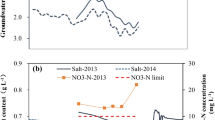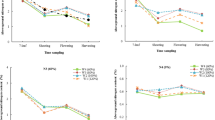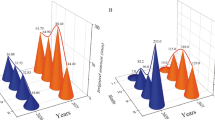Abstract
The adverse effect of temporary flooding on maize (Zea mays L.) yields and the nitrogen management required to mitigate the effect of flooding were studied for five years in field experiments on Choa sandy loam soil.
Maize yields decreased with increase in duration of flooding and with decrease in the age of the crop at the time of flooding. Flooding periods exceeding 48 hours caused significant crop damage. The loss in yield on account of flooding was, however, less in 40-day old crops. A 24 hours flooding decreased grain yield by 17.7 and 3.9 per cent in 20-day and 40-day old crops respectively. Maximum yield loss amounted to 1.23 t ha−1 of grains with 72 hours of flooding of 20-day old crop indicating that a younger crop is more prone to the deleterious effect of flooding.
The nitrogen content of grains decreased significantly with increase in flooding period. A supplemental dose of 7 kg N ha−1 as urea spray significantly increased grain yield. Soil application of supplemental nitrogen at the rate of 14 or 20 kg N ha−1 enhanced the maize yield by 0.7 to 0.9 t ha−1 under temporary flooded conditions. Spraying with urea solution increased nitrogen removed by the crop.
Successive increments of 60 kg N ha−1 gave an additional yields of 1.23, 1.01 and 0.41 t ha−1 over the crop that received no nitrogen. Flooded maize responded to even higher rates of N fertilization than the dose of 120 kg N ha−1 which is recommended in this region.
Similar content being viewed by others
References
Bremner JM (1965) Inorganic forms of nitrogen. In methods of Soil Analysis, part II (Eds. Black CA et al.) Amer Soc Agron Inc., Wisconsin, USA p. 1179–1237
Chaudhry TN, Bhatnagar VK and Prihar SS (1975) Corn yield and nutrient uptake as affected by Water-Table depth and soil submergence. Agron J 67, 745–749
Joshi, MS and Dastane NG (1965) Studies on excess water tolerance of crop plants. Indian J Agron 10, 289–298
Khera KL and Singh NT (1975) Fertilizer-aeration interaction in maize (Zea mays L.) under temporary flooding. J Indian Soc Soil Sci 23, 336–343
Lal R and Taylor GS (1969) Drainge and nutrient effects in a field lysimeter study:I Corn yields and soil conditions. Soil Sci Soc Am Proc 33, 937–941
Letey J and Stolzy LH (1964) Measurement of oxygen diffusion rates with platinum electrode I. Theory and equipment. Hilgardia 35, 545–554
Purvis AC and Williamson RE (1972) Effects of flooding and gaseous composition of the root environment on growth of corn. Agron J 64, 674–678
Schwab GO, Taylor GS, Fouse JF and Stibbe E (1966) Crop response from tile and surface drainage. Soil Sci Soc Am Proc 30, 634–637
Shalhevet J and Zwerman PJ (1962) Nitrogen response of corn under variable conditions of drainage — A lysimeter study. Soil Sci 93, 172–182
Stolzy LH and Letey J (1964) Measurement of oxygen diffusion rate with platinum electrode. Correlation of plant responses to soil oxygen diffusion rates. Hilgardia 35, 567–576
Author information
Authors and Affiliations
Rights and permissions
About this article
Cite this article
Singh, N., Vig, A. & Singh, R. Nitrogen response of maize under temporary flooding. Fertilizer Research 6, 111–120 (1985). https://doi.org/10.1007/BF01051005
Accepted:
Issue Date:
DOI: https://doi.org/10.1007/BF01051005




